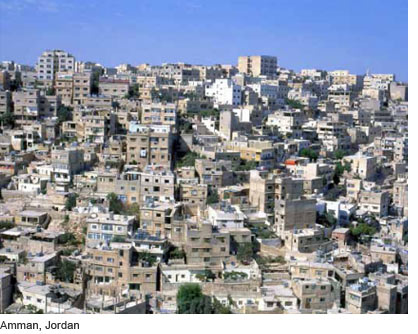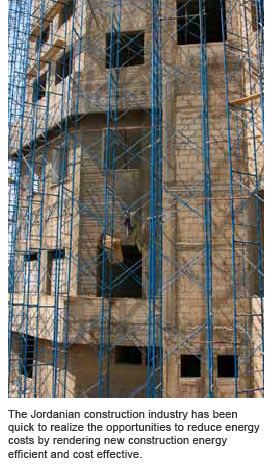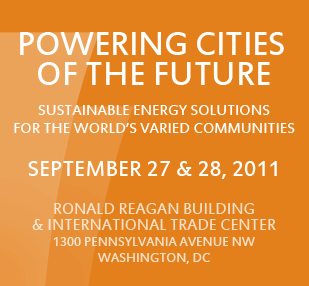By Yahya Kisbi
  ith the world’s population now at seven billion and rising rapidly, the growth in demand for shelter and consumable such as energy, water and food is set to increase dramatically. More than 50 percent of the world’s population now lives in cities and the urbanization continues unabated. ith the world’s population now at seven billion and rising rapidly, the growth in demand for shelter and consumable such as energy, water and food is set to increase dramatically. More than 50 percent of the world’s population now lives in cities and the urbanization continues unabated.
In Jordan, 80 percent of our citizens now reside in urban areas and this proportion will only increase as our present population of 6 million passes 7.5 million in 2020 and 12 million in 2040.
Providing for our own needs while allowing for coming generations and simultaneously combating environmental degradation is a challenge for us all.
Jordan is already one of the world’s most water-stressed countries, with 95 percent of our land desert and much of the rest susceptible to desertification. Unlike others in our region, we have no conventional oil reserves and currently import 96 percent of our energy requirement at a cost of 13 percent of GDP.
With present energy demand of 2,500 MW and predicted to grow to 4,550 MW by 2020 and 6,000 MW by 2030 we are left with no option but to adopt innovative, resource efficient and environmentallyresponsive development.
With existing residential properties consuming 24 percent of our energy, approximately the same proportion as our industries, and commercial activities using 14 percent, initiatives to reduce the amount of energy used in both the construction and operation of buildings will increasingly contribute to attaining the National Energy Strategy 2007- 2020 target of reducing total consumption by 20 percent through improved efficiency.
No longer can we afford to expand and operate our towns and cities according to the ways of the past. The 30,000 students currently studying architecture and engineering at Jordanian universities will need to spend their careers pursuing a different set of environmental, geopolitical and social and cultural priorities from those who came before them.
We will, of course, learn from past successes, in which the Arab World has a head’s start. Previous generations lived and prospered under adverse climatic conditions, adapting their culture and traditions to be environmentally- responsive.
Many of the urban planning and architectural features now espoused by sustainability gurus and green building advocates have long characterized Arabian urban landscapes.
Buildings are positioned to maximize the benefits of cooling breezes and minimize solar gain. Tall, tightly-spaced buildings within high walls along narrow streets create shade, with interspersed barahaat, today’s ‘pocket parks’ adding to natural cooling.
Arcaded souks improve outdoor comfort as well, while central courtyards with fountains, wind towers and traditional window screens, musharabia, greatly enhance the indoor environment and reduce the energy expended for space conditioning.
Like many of our neighbors, Jordanians at all levels of society are rising to meet the global energy challenge by rediscovering our traditions and adopting them in pursuit of modern metrics for sustainable development.
 The Jordanian construction industry has been quick to realize the opportunities to reduce energy by rendering new construction, renovations and operational management energy efficient and cost effective. The Jordanian construction industry has been quick to realize the opportunities to reduce energy by rendering new construction, renovations and operational management energy efficient and cost effective.
Voluntary green building rating systems such as the USA’s LEED and UK’s BREEAM are being enthusiastically embraced by urban planners, design consultants, construction contractors, trade organizations, materials suppliers and others.
The Jordan National Building Council and the Building Research Centre at the Royal Scientific Society has initiated the development of an Energy Efficient Building Code for Jordan, to improve thermal performance and minimize energy consumption while maintaining thermal comfort, adequate lighting and other key performance indicators of modern living.
Since 2009 the Jordan Green Building Council has advocated for environmentally- responsive construction concepts and practices appropriate for the Kingdom.
Also like our neighbors, we are developing renewable energy sources and realistically expect them to account for 7 percent of peak demand by 2015 and 10 percent by 2020.
These estimates are based on plans to generate 600 MW from wind, 300-600 MW from solar thermal, and 30-50 MW from waste.
Jordan is also fortunate in having extensive reserves of oil shale that provide a costeffective alternative to conventional hydrocarbons when the oil price exceeds $65/barrel, a price not seen for any significant length of time for several years.
With our exposure to solar energy estimated at 5.5 kWh/ m2/day, the potential for solar initiatives is particularly relevant to Jordan.
The future for all types of renewable energy was greatly assisted by the cabinet’s 2010 approval of the Renewable Energy and Energy Efficiency Law allowing the Ministry of Energy and Mineral Resources to initiate energy conservation across various sectors of activity and to encourage renewable energy projects throughout the Kingdom.
A new Solar Energy Code and a Green Building Code have also been drafted.
Fiscal incentives to promote energy investment are also important. The 2007 Energy Strategy offers income tax exemptions of 100 percent over 10 years to independent energy projects that increase the contribution of local energy sources to the national energy mix through Build-Operate- Own (BOO) or Build-Operate- Transfer (BOT) projects.
In specifically targeting the use of renewables, the strategy provides for a number of incentives including:
- The progressive removal of oil and electricity price subsidies to make them cost reflexive;
- The establishment of an energy data bank;
- The provision of grants and soft loans for large renewable energy projects;
- The elimination or reduction of sales tax and/or custom duties on materials and equipment contributing to energy saving, such as thermal insulation;
- Creation of an Energy Efficiency label for local and imported appliances;
- The obligation for large industrial and commercial institutions to conduct energy audits.
Another important initiative has been the establishment of the Renewable Energy and Energy Efficiency Fund that promotes energy audits for industrial SMEs and offers limited assistance for energy efficiency implementation.
The overall investment package to meet the Strategy objectives is US$1.4-2.2 billion.
Having adopted a strategy in which energy conservation is a fundamental tenet, it is inherent upon industry professionals to not only minimize operational energy demands of new and renovated buildings as required by the Energy Efficient Building Code and optional green building rating systems, but to also aim at reducing the energy used within the industry itself.
In the USA this equates to more than 11 percent of total national energy consumption, split almost equally between that consumed in the construction of buildings and that in providing infrastructure.
Yahya Kisbi is Jordan’s minister of public works and housing.
|


